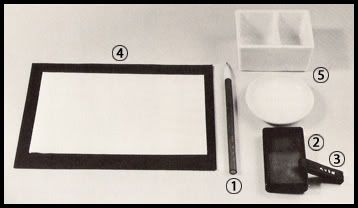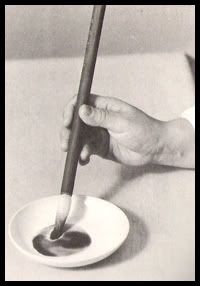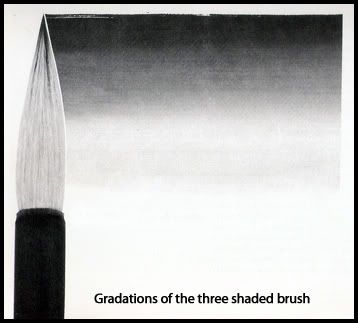Thursday, May 3, 2007
Basic Preparation for Sumi-e Painting

The materials you will need for sumi-e can be purchased at most stores specializing in Oriental goods or from art shops. Prices will vary, depending on the store and on the quality of the items.
1. Brush.
There are many kinds of fude (sumi-e brushes). You will need just one brush. Its bristles made from deer, goat, or boar hair, should be about 1 5/8 inches long with a diameter of about 3/8 inches (or about 40mm by 10mm). New brushes often contain starch in their bristles to stiffen and protect them during shipment. Soften the brush by pressing it repeatedly with light pressure onto a small water-filled plate until the starch runs off. After use, rinse the brush thoroughly with clear water.
2. Suzuri.
Suzuri (ink stone) are carved from stone and have a well to hold water and a flat surface on which the sumi (ink) stick is ground or rubbed to produce ink. Suzuri comes in many different shapes and sizes. After use, clean the suzuri thoroughly with running water. Old, dried sumi on the suzuri is very hard to remove and will interfere with the even rubbing of the sumi stick.
3. Sumi stick.
Sumi sticks are made from powdered carbon of burnt pine or lamp black, plus a binding agent. When a sumi stick is rubbed back and forth with a small amount of water on the level surface of the suzuri, small carbon particles come off the stick and dissolve in the water to produce ink. Four different “black” shades are available: black-black and black-brown (used for winter or rocky, mountainous scenes) and black-blue and black-purple (for gentle springtime scenes). You can use any of these shades, but the black-blue sumi will probably show your work off best in the beginning.
4. Paper and cloth.
Sumi-e is best done on kind of paper that will absorb moisture from the wet brush as you paint. Any kind of paper with this characteristic will do, and even ordinary newspaper can be used for practicing. Flat sheets of gasenshi (often called “rice paper” in the West but actually made from plant fibers) are particularly well suited for sumi-e. Gasenshi can be purchased at the store where you buy your other materials.
A cloth, preferably a piece of felt, may be placed under the paper to absorb excessive moisture.
Sumi-e paper is very delicate and should be stored flat in its wrapper. Paper in rolls is sometimes available, but you may need to use a weight to hold the paper, preventing it from curling while you work.
5. Small dish and bowl.
You will need a small dish in which to make medium-color ink. A small double-welled bowl filled with water can be used to wash and moisten your brush.
PREPARATION
Lay out the sumi-e materials on a desk or table as shown in the photograph. Pour clean water into the well of the suzuri and into the small bowl until they are each about three-quarters full.
Making ink Hold the sumi stick vertically against the suzuri’s surface. Dip its lower end into the well of the suzuri and draw some of the water up onto the suzuri’s level surface. Carefully and with even strokes—but without too much pressure—rub the sumi stick over the surface, back and forth. Keep the sumi stick perpendicular; rubbing at an angle will cause carbon particles to come off the stick unevenly and will result in poor ink. Five to ten seconds should give you good sumi. You will be applying sumi to your brush directly from suzuri’s level surface; when the sumi has been used up, just repeat the above process to make more.
Hold the sumi stick vertically against the suzuri’s surface. Dip its lower end into the well of the suzuri and draw some of the water up onto the suzuri’s level surface. Carefully and with even strokes—but without too much pressure—rub the sumi stick over the surface, back and forth. Keep the sumi stick perpendicular; rubbing at an angle will cause carbon particles to come off the stick unevenly and will result in poor ink. Five to ten seconds should give you good sumi. You will be applying sumi to your brush directly from suzuri’s level surface; when the sumi has been used up, just repeat the above process to make more.
The depth of color is the result of the amount of water you use and the length of time you rub the sumi stick. As you gain experience you will know the thickness of the ink you need, that will differ according to the object you want to paint and the effect you want to create.
You will often need sumi of medium color to paint light lines or to change the brush with different sumi shades. To make medium-color sumi, use the tip of your brush to transfer small amount of dark sumi from the suzuri to the small dish, the dilute the ink with a few drops of water from your wet brush and mix until the desired tone of color is obtained.
Applying sumi to the brush Never apply sumi to a dry brush. Dip the brush in water and gently swab its bristles against the edge of the bowl to prevent dripping. If you need to use only the tip of the brush to paint a fine line, remove more water from the brush. This will make the bristles firmer, giving better support and control as you paint.
Never apply sumi to a dry brush. Dip the brush in water and gently swab its bristles against the edge of the bowl to prevent dripping. If you need to use only the tip of the brush to paint a fine line, remove more water from the brush. This will make the bristles firmer, giving better support and control as you paint.
You may charge the brush with dark sumi only, with medium-color sumi only, or with the combination of the two. When a brush is charged with two tones of ink plus water, the ink tones and water overlap and blend together on the paper to give the painted line the appearance of depth. Western artist add depth using fine shading techniques; but the sumi-e artist can get the same effect with a single stroke of the brush. To prepare this “three-shaded” brush (water can thought of as one shade), draw the wet brush through the medium-color sumi you have prepared in the small dish; let the medium-color sumi evenly saturate two-thirds of the brush from the tip up. Then draw the brush through the dark sumi on the level surface of the suzuri, but this time let the sumi saturate only the lower third of the bristles. The result will be a brush charged, from the tip up, with one-third dark sumi, one-third medium-color sumi, and one-third water.
To prepare this “three-shaded” brush (water can thought of as one shade), draw the wet brush through the medium-color sumi you have prepared in the small dish; let the medium-color sumi evenly saturate two-thirds of the brush from the tip up. Then draw the brush through the dark sumi on the level surface of the suzuri, but this time let the sumi saturate only the lower third of the bristles. The result will be a brush charged, from the tip up, with one-third dark sumi, one-third medium-color sumi, and one-third water.
When painting a thin line, you can saturate less of the brush with sumi; but the medium and dark shades of sumi on the brush should always be kept in the ratio of two to one. When using a dark or medium shade alone, apply only as much sumi to the brush as you need.
latest news
Labels
- another form of art (1)
- art book (1)
- art industries (2)
- art news (1)
- Asian Arts (1)
- atelier (1)
- auction (1)
- cigar (1)
- coffee painting (1)
- color (1)
- composition (2)
- decorating (1)
- decorating home (1)
- decorating office (1)
- decorating tips (1)
- decorative art (1)
- decorative wall painting (1)
- drawing (2)
- drawing guide book (1)
- expressionism (1)
- famous oil paintings (3)
- famous painting artists (4)
- impressionism (2)
- indonesian arts (1)
- Inspirations (1)
- mirror art (1)
- oil painting (4)
- oil painting artists (2)
- oil painting medium (1)
- oil painting techniques (1)
- oil painting tips (4)
- oil painting tools (1)
- online gallery (1)
- painting (1)
- painting tips (1)
- pallet (1)
- sumi-e (1)
- tatoo ideas (1)
- tattoo art (2)
- tattoo book (1)
- tips (6)
- tools (1)
- white (1)
Neighboring Blogs
| Allright Reserved Oil and painting | Powered BY B L O G G E R | Layout by OIL Painting |






0 comments:
Post a Comment